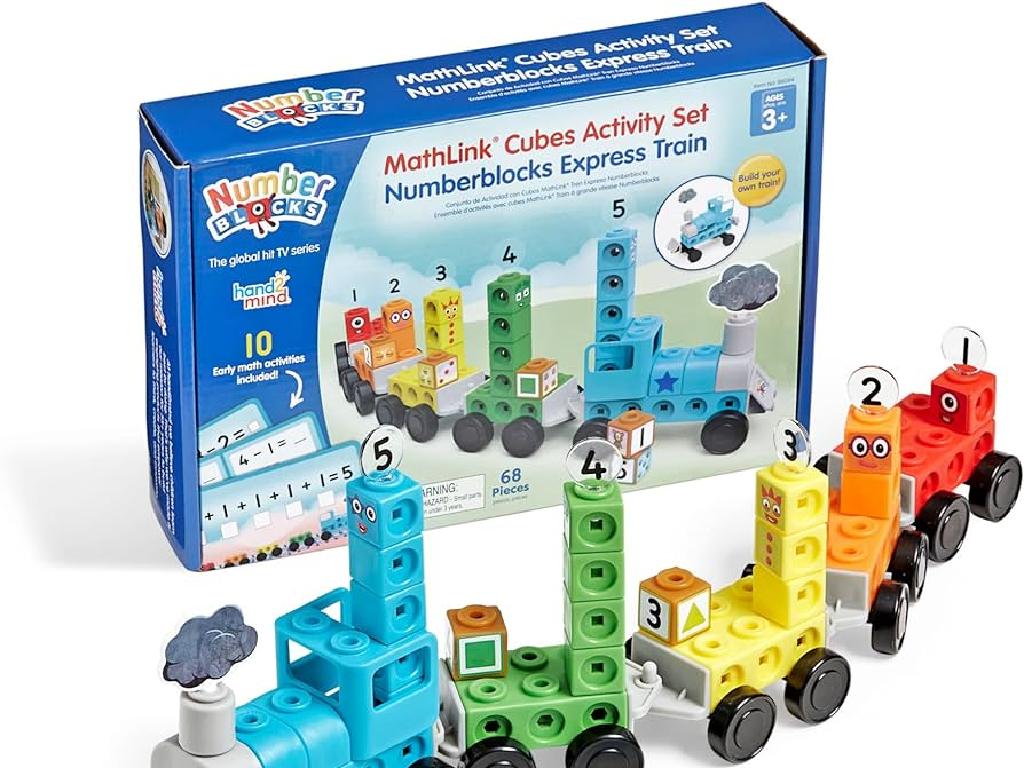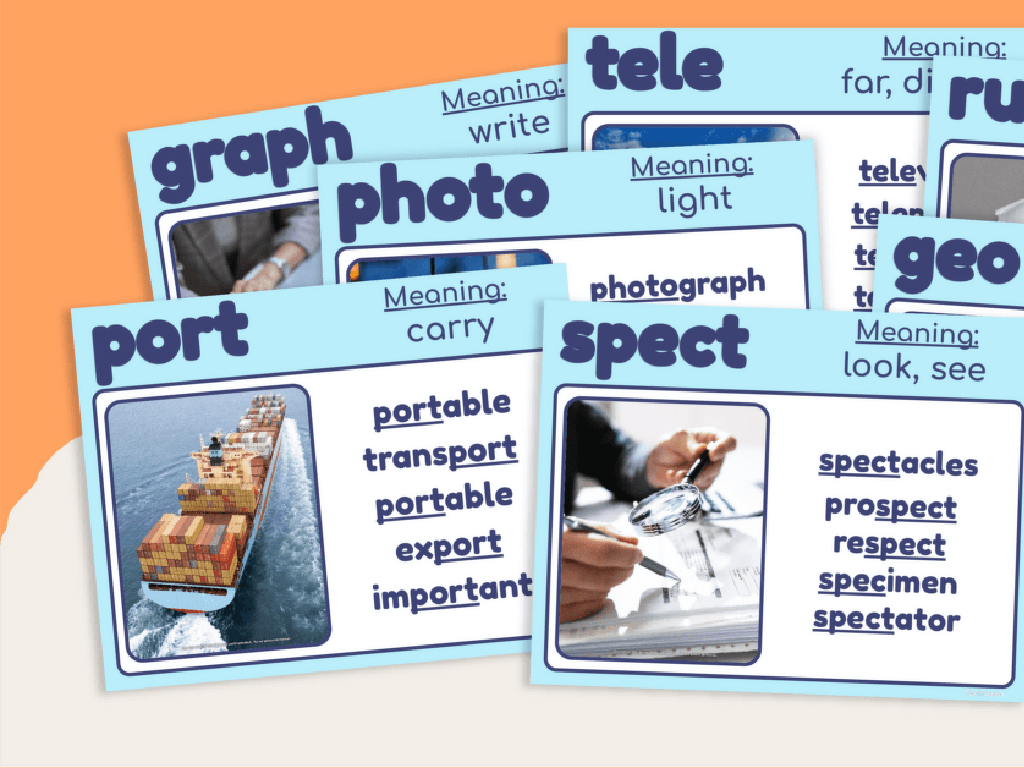Sort Words With Shared Prefixes And Suffixes By Meaning
Subject: Language arts
Grade: Fifth grade
Topic: Prefixes And Suffixes
Please LOG IN to download the presentation. Access is available to registered users only.
View More Content
Exploring Prefixes and Suffixes
– Building blocks of words
– Defining prefixes and suffixes
– Prefixes are beginnings, suffixes are endings added to root words.
– The power of prefixes and suffixes
– They can alter a word’s meaning, making a new word.
– Examples in action
– ‘Unhappy’ has ‘un-‘ prefix meaning ‘not’; ‘teaching’ has ‘ing’ suffix indicating ‘action of.’
|
This slide introduces students to the concept of prefixes and suffixes, the essential components that form many words in the English language. Begin by explaining that prefixes are added to the beginning of root words to change their meaning, while suffixes are added to the end. Emphasize how these word parts can completely alter the meaning of the base word, and provide examples to illustrate this. For instance, adding ‘un-‘ to ‘happy’ changes the meaning to its opposite, and adding ‘-ing’ to ‘teach’ turns a verb into a noun indicating the action. Encourage students to think of more examples and discuss how the meaning changes with different prefixes and suffixes.
Exploring Prefixes
– Define a prefix
– A prefix is added to the start of a word to change its meaning.
– Prefix examples: ‘un-‘, ‘re-‘, ‘pre-‘, ‘dis-‘
– ‘un-‘ means not, ‘re-‘ means again, ‘pre-‘ means before, ‘dis-‘ means the opposite of.
– Prefixes modify meanings
– By adding a prefix, we alter what the base word means.
– Example: ‘happy’ to ‘unhappy’
– ‘Unhappy’ means not happy, showing how ‘un-‘ changes the word.
|
This slide introduces the concept of prefixes to the students. A prefix is a set of letters that we add to the beginning of a word to change its meaning. Provide examples of common prefixes like ‘un-‘, ‘re-‘, ‘pre-‘, and ‘dis-‘ and explain what each one means. Show how these prefixes transform the meanings of base words, using ‘happy’ and ‘unhappy’ as a clear example. Encourage students to think of other words they know and discuss how adding a prefix changes their meanings. This will help them understand how prefixes can be used to form antonyms or indicate repetition, timing, or negation.
Exploring Suffixes
– Definition of a suffix
– A suffix is added to a word’s end
– Common suffix examples
– Examples: ‘-ful’, ‘-less’, ‘-ness’, ‘-ment’
– Suffixes alter word meaning
– They can modify tense, form, or meaning
– From ‘joy’ to ‘joyful’
– ‘Joyful’ means full of joy
|
This slide introduces the concept of suffixes to the students. A suffix is a set of letters that is added to the end of a word to change its meaning or grammatical function. Common suffixes include ‘-ful’, ‘-less’, ‘-ness’, and ‘-ment’, each of which alters the original word in a specific way. For example, adding ‘-ful’ to ‘joy’ creates ‘joyful’, which means full of joy. It’s important to show students how suffixes can change not just the meaning but also the tense and form of words. Encourage students to think of other words they know and discuss how adding different suffixes can change their meanings. This understanding will help them decode unfamiliar words and enrich their vocabulary.
Sorting Words by Prefixes
– Group words with common prefixes
– Discuss prefix impact on meaning
– Prefixes like ‘un-‘, ‘re-‘, and ‘pre-‘ modify the base word’s meaning
– Activity: Prefixes in action
– Identify prefixes and their meanings in given words
– Understanding ‘redo’, ‘preheat’, ‘disagree’
– ‘Re’ means again, ‘pre’ means before, ‘dis’ means not or apart
|
This slide introduces the concept of prefixes and how they alter the meanings of base words. Start by explaining that a prefix is a group of letters added to the beginning of a word. Have students group words by common prefixes and discuss as a class how each prefix changes the word’s meaning. For the activity, students will identify the prefix in ‘redo’, ‘preheat’, ‘disagree’ and explain the new meaning. ‘Redo’ means to do again, ‘preheat’ means to heat before, and ‘disagree’ means not to agree. This exercise will help students understand how prefixes can change the meaning of words and how to sort them accordingly. Encourage students to think of other words with the same prefixes and discuss their meanings.
Sorting Words by Suffixes
– Group words with similar suffixes
– Like ‘-ness’ in ‘kindness’, ‘darkness’
– Suffixes change word types
– ‘Care’ (noun) to ‘careful’ (adjective)
– Activity: Matching suffixes
– Match suffixes to their meaning and part of speech
– Explore ‘hopeful’, ‘careless’, ‘happiness’
– Analyze how ‘hopeful’, ‘careless’, ‘happiness’ differ
|
This slide introduces the concept of suffixes and their role in altering the meaning and part of speech of a base word. Start by explaining that a suffix is a letter or group of letters added to the end of a word. Have students group words by common suffixes and discuss how these suffixes change the words from one part of speech to another (e.g., ‘care’ is a noun, but when the suffix ‘-ful’ is added, it becomes the adjective ‘careful’). For the activity, provide students with a list of suffixes and words to match them with their impact on meaning and part of speech. Use examples like ‘hopeful’, ‘careless’, and ‘happiness’ to illustrate the concept. Encourage students to think of other words with the same suffixes and discuss as a class how the suffixes change the words’ meanings.
Exploring Prefixes and Suffixes
– Prefixes/suffixes alter meanings
– ‘Un-‘ means not; ‘unbelievable’ means not believable
– Use context to understand words
– Context clues are hints to the meaning
– ‘unbelievable’ in a sentence
– ‘The magician’s trick was unbelievable.’
– ‘kindness’ and ‘renewable’ examples
– ‘Her kindness warmed their hearts.’ / ‘Solar energy is renewable.’
|
This slide aims to help students grasp how prefixes and suffixes modify the meanings of words and how to use context to determine these new meanings. By examining the prefix ‘un-‘ in ‘unbelievable’, students can see it negates the word ‘believable’, changing the meaning to ‘not believable’. Context clues within sentences provide hints that aid in understanding unfamiliar words. The example sentences provided will help students see these concepts in action. Encourage students to create their own sentences using new words with prefixes and suffixes to reinforce their learning.
Class Activity: Crafting Words with Prefixes and Suffixes
– Create new words with given prefixes and suffixes
– Explain the meanings of your new words
– Think about how each prefix or suffix alters a word’s meaning
– Share your words with the class
– Use your words in creative sentences
– How would your word fit in a story or conversation?
|
This activity is designed to help students understand how prefixes and suffixes change the meanings of base words and how they can create new words with different meanings. Provide a list of common prefixes and suffixes to the class and let them experiment with combining them with different base words. Encourage creativity and exploration. After students have created their words, ask them to explain the meanings based on their understanding of the prefixes and suffixes used. Then, have them share their words with the class to foster a collaborative learning environment. Finally, challenge them to use their new words in sentences, which will help solidify their understanding and give them practical experience with the new vocabulary. For the teacher: Prepare a diverse list of prefixes and suffixes, consider grouping students for brainstorming, and have a few examples ready to demonstrate the activity.
Review and Practice: Prefixes and Suffixes
– Recap on prefixes and suffixes
– Review the meaning of common prefixes and suffixes
– Engage in an interactive quiz
– Test understanding with a fun quiz
– Create sentences with new words
– Use newly learned words in original sentences
– Discuss and share with the class
– Share your sentences and learn from others
|
Begin the slide by quickly reviewing the definitions and examples of prefixes and suffixes, ensuring that students recall the concepts. Move on to an interactive quiz, which can include matching prefixes/suffixes with their meanings or identifying them in given words. After the quiz, encourage students to apply their knowledge by creating their own sentences using words with prefixes and suffixes. This activity helps solidify their understanding. Finally, have students share their sentences with the class, fostering a collaborative learning environment. The teacher should provide feedback and guide discussions to clarify any misunderstandings.
Homework: Exploring Prefixes and Suffixes
– Find 5 words with prefixes
– Find 5 words with suffixes
– Write words and meanings
– Write down the new words and what you think they mean
– Explain prefix/suffix effect
– How does adding a prefix or suffix change the meaning of the base word?
|
This homework assignment is designed to help students recognize and understand the role of prefixes and suffixes in word formation and meaning. By finding words in a context they enjoy, students will be more engaged and likely to remember the concepts taught. Encourage them to look for common prefixes like ‘un-‘, ‘re-‘, ‘pre-‘, and suffixes like ‘-ful’, ‘-less’, ‘-ness’. They should write down the base word, the new word with the prefix or suffix, and explain how the meaning changes. This will help them see the patterns in word formation and enhance their vocabulary. In the next class, ask students to share their findings and discuss any interesting discoveries or challenging words they encountered.
Wrapping Up: Prefixes and Suffixes
– Recap: Prefixes and Suffixes
– They change the meaning of root words.
– Spot them in daily reading
– Keep an eye out for them in books, signs, and more.
– Remember your homework
– Complete the worksheet on sorting words by meaning.
|
As we conclude, reiterate the importance of prefixes and suffixes in understanding the meaning of words. Encourage students to be detectives in their everyday reading, looking for these word parts and considering how they modify the meaning of the root words. Remind them of their homework assignment, which is to complete a worksheet that requires them to sort words based on their prefixes and suffixes. This exercise will help reinforce today’s lesson and give them practical experience in identifying and understanding these critical components of English vocabulary.






